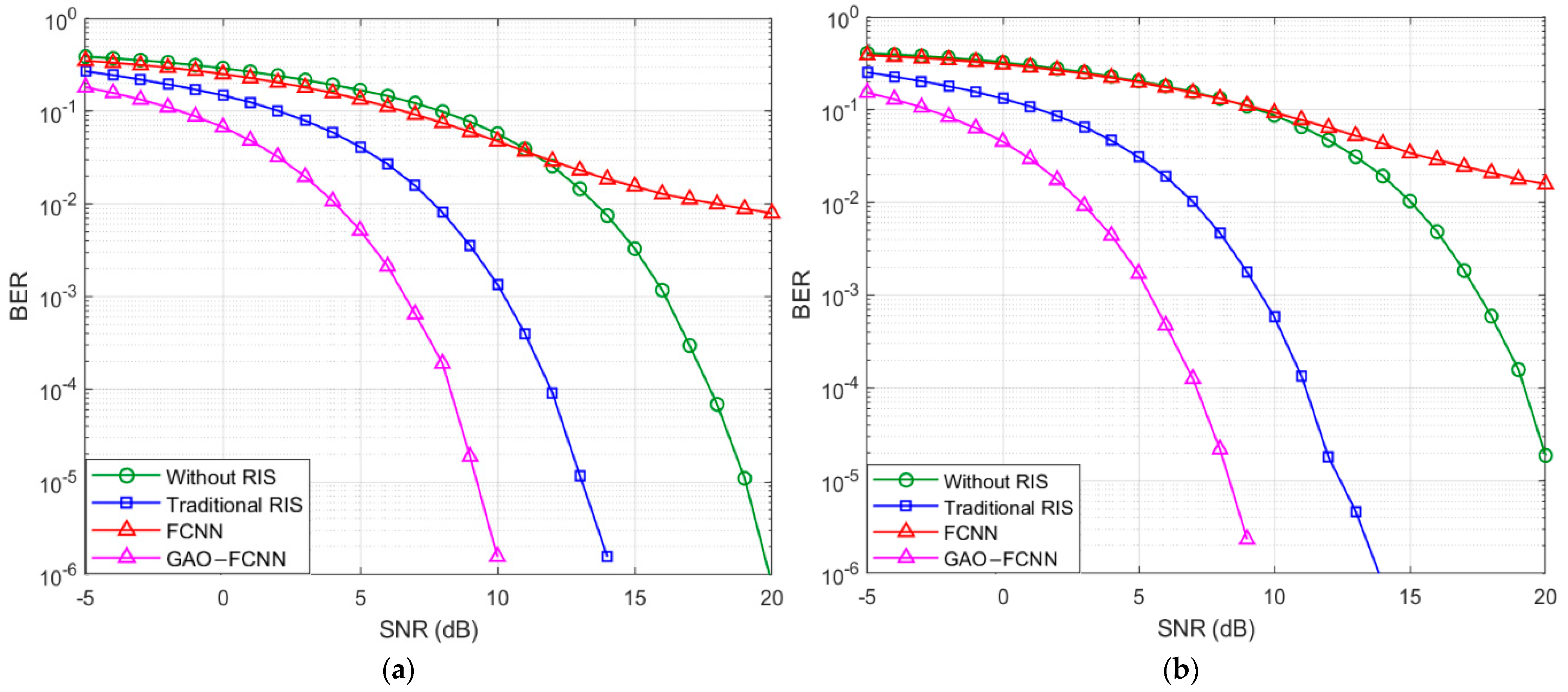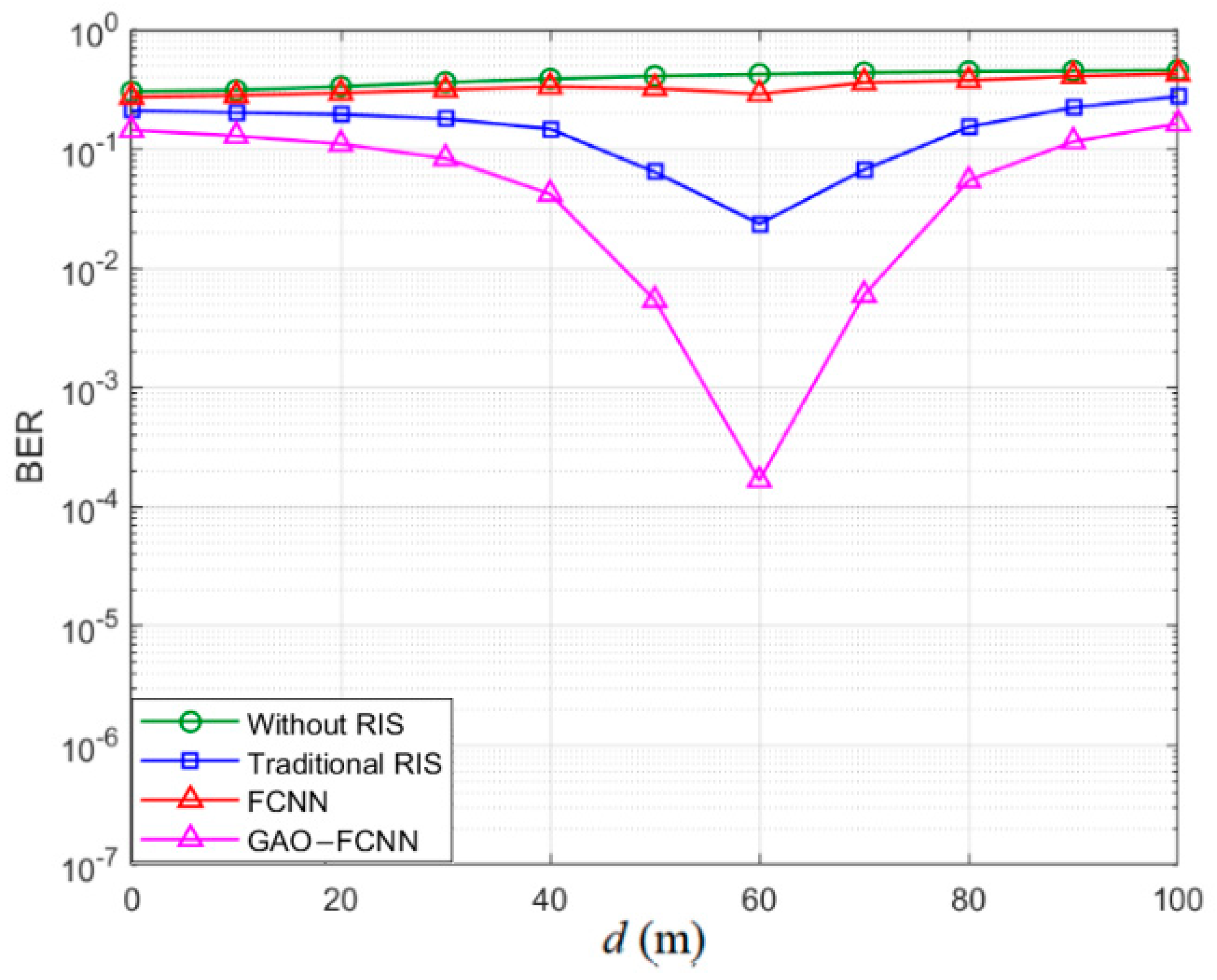GAO–FCNN–Enabled Beamforming of the RIS–Assisted Intelligent Communication System
Abstract
1. Introduction
2. System Model
3. GAO–FCNN
3.1. Fully–Connected Neural Network
| Algorithm 1: The essential process pertaining to the FCNN |
| # forward propagation |
| Input: |
| Initialize: |
| For every layer from 1 to do: |
| # Linear transformation |
| # Activation function |
| Output: (activation values of the final output layer) |
| # back propagation |
| Input: (true labels), CE loss function |
| Initialize: means derivative of the normalized output vector l-th layer with respect to |
| For each layer from 1 to do: |
| If is not the output layer: |
| Compute the weight regularization loss |
| Else: |
| # Compute gradient |
| # Compute weight gradient |
| = np.sum(, axis = 1, keep dims = True) # Compute bias gradient, axis = 1 sums across rows |
| # Update weight values and biases |
| Output: Updated and for all layers |
3.2. Genetic Algorithm Optimization
| Algorithm 2: The core process pertaining to the GAO |
| Input: population size , crossover likelihood (Pc = 0.65), mutation likelihood (Pm = 0.025), the maximum allowable number of functions evaluated (FESmax = ) |
| / * z is the current evolutionary generation number, and Best represents the optimal solution currently found, */ |
| Procedure GA |
| z ← 0; |
| ←initialize); // initialize the population |
| ←evaluate) // evaluation of adaptive value |
| keep_best); // save the optimal chromosome |
| FE = |
| while(termination conditions not met) do |
| begin |
| ←selection); // select the operator |
| ←crossover); // mating operator |
| ←mutation); // variation operator |
| z←z + 1; |
| ←; |
| evaluate); |
| FE←FE+; |
| If optimal adaptation for is greater than Best |
| replace); |
| end if |
| end while |
| end procedure |
| Output: Optimal adaptive value, |
4. Numerical Results
5. Conclusions
Author Contributions
Funding
Data Availability Statement
Acknowledgments
Conflicts of Interest
References
- Basar, E. Reconfigurable intelligent surface–empowered MIMO systems. Natl. Sci. Rev. 2023, 10, nwad096. [Google Scholar] [CrossRef]
- Jiang, H.; Mukherjee, M.; Zhou, J.; Lloret, J. Channel modeling and characteristics analysis for 6G wireless communications. IEEE Netw. 2021, 35, 296–303. [Google Scholar] [CrossRef]
- Guo, H.; Liang, Y.C.; Chen, J.; Larsson, E.G. Weighted sum–rate maximization for intelligent reflecting surface enhanced wireless networks. In Proceedings of the 2019 IEEE Global Communications Conference (GLOBECOM), Waikoloa, HI, USA, 9–13 December 2019; IEEE: Piscataway, NJ, USA, 2020. [Google Scholar] [CrossRef]
- Li, S.; Duo, B.; Yuan, X.; Liang, Y.C.; Renzo, M.D. Reconfigurable intelligent surface assisted UAV communication: Joint trajectory design and passive beamforming. IEEE Wirel. Commun. Lett. 2020, 9, 716–720. [Google Scholar] [CrossRef]
- Chang, D.; Jiang, H.; Zhou, J.; Zhang, H.; Mukherjee, M. Capacity optimization using augmented Lagrange method in intelligent reflecting surface–based MIMO communication systems. China Commun. 2020, 17, 123–138. [Google Scholar] [CrossRef]
- Zhou, Q.; Gong, Y.; Nallanathan, A. Radar–assisted beam selection in MIMO communication systems: A federated transfer learning approach. IEEE Trans. Veh. Technol. 2024, 73, 12172–12177. [Google Scholar] [CrossRef]
- Wu, Q.; Zhang, R. Intelligent Reflecting Surface Enhanced Wireless Network via Joint Active and Passive Beamforming. IEEE Trans. Wirel. Commun. 2019, 18, 5394–5409. [Google Scholar] [CrossRef]
- Zhang, S.; Zhang, R. Capacity Characterization for Intelligent Reflecting Surface Aided MIMO Communication. IEEE J. Sel. Areas Commun. 2020, 38, 1823–1838. [Google Scholar] [CrossRef]
- Chen, Z.; Guo, Y.; Zhang, P.; Jiang, H.; Xiao, Y.; Huang, L. Physical layer security improvement for hybrid RIS–assisted MIMO communications. IEEE Commun. Lett. 2024; early access. [Google Scholar] [CrossRef]
- Bao, H.; Fang, J.; Chen, Z.; Li, H.; Li, S. An efficient bayesian PAPR reduction method for OFDM–based massive MIMO systems. IEEE Trans. Wirel. Commun. 2016, 15, 4183–4195. [Google Scholar] [CrossRef]
- Ye, J.; Guo, S.; Alouini, M.-S. Joint Reflecting and Precoding Designs for SER Minimization in Reconfigurable Intelligent Surfaces Assisted MIMO Systems. IEEE Trans. Wirel. Commun. 2020, 19, 5561–5574. [Google Scholar] [CrossRef]
- Yan, Y.; Wang, Y.; Ni, W.; Niyato, D. Joint beamforming design for multi–functional RIS–assisted uplink communications. IEEE Commun. Lett. 2023, 27, 2697–2701. [Google Scholar] [CrossRef]
- Zhang, L.; Wu, D.; Zhao, M.J.; Nan, H. Uncertainty relation and the constrained quadratic programming. Phys. Scr. 2024, 99, 065103. [Google Scholar] [CrossRef]
- Dang, D.C.; Friedrich, T.; Kötzing, T.; Krejca, M.S.; Lehre, P.K.; Oliveto, P.S.; Sudholt, D.; Sutton, A.M. Escaping local optima using crossover with emergent diversity. IEEE Trans. Evol. Comput. 2018, 22, 484–497. [Google Scholar] [CrossRef]
- Fedorenko, V.A.; Sorokina, K.O.; Giverts, P.V. Multigroup classification of firing pin impressions with the use of a fully connected neural network. Program. Comput. Soft. 2024, 50, 73–84. [Google Scholar] [CrossRef]
- Muñoz, A.; Rubio, F. Evaluating genetic algorithms through the approximability hierarchy. J. Comput. Sci. 2021, 53, 101388. [Google Scholar] [CrossRef]
- Li, M.; Bouanani, F.E.; Tian, L.; Chen, W.; Han, Z.; Muhaidat, S. Error rate analysis of non-orthogonal multiple access with residual hardware impairments. IEEE Commun. Lett. 2021, 25, 2522–2526. [Google Scholar] [CrossRef]
- Cui, M.; Zhang, G.; Zhang, R. Secure wireless communication via intelligent reflecting surface. IEEE Wirel. Commun. Lett. 2019, 8, 1410–1414. [Google Scholar] [CrossRef]
- Gökceli, S.; Levanen, T.; Riihonen, T.; Renfors, M.; Valkama, M. Frequency–selective PAPR reduction for OFDM. IEEE Trans. Veh. Technol. 2019, 68, 6167–6171. [Google Scholar] [CrossRef]
- Dastoor, S.; Patel, H. Performance analysis of massive MIMO using various transmit precoding schemes for a wireless network. Int. J. Commun. Syst. 2024, 37, e5785. [Google Scholar] [CrossRef]
- Lipka, M.; Jarzyna, M.; Banaszek, K. Quantum Fingerprinting Over AWGN Channels with Power–Limited Optical Signals. IEEE J. Sel. Areas Commun. 2020, 38, 496–505. [Google Scholar] [CrossRef]
- Canbilen, A.E.; Basar, E.; Ikki, S.S. On the performance of RIS–assisted space shift keying: Ideal and non-ideal transceivers. IEEE Trans. Commun. 2022, 70, 5799–5810. [Google Scholar] [CrossRef]
- Singh, U.; Bhatnagar, M.R.; Bansal, A. RIS–assisted SSK modulation: Reflection phase modulation and performance analysis. IEEE Commun. Lett. 2022, 26, 1012–1016. [Google Scholar] [CrossRef]
- Xiong, B.; Zhang, Z.; Jiang, H.; Zhang, J.; Wu, L.; Dang, J. A 3D non-stationary MIMO channel model for reconfigurable intelligent surface auxiliary UAV–to–ground mmWave communications. IEEE Trans. Wirel. Commun. 2022, 21, 5658–5672. [Google Scholar] [CrossRef]
- Jiang, H.; Xiong, B.; Zhang, H.; Basar, E. Physics–Based 3D End-to-End Modeling for Double–RIS Assisted Non-Stationary UAV-to-Ground Communication Channels. IEEE Trans. Commun. 2023, 71, 4247–4261. [Google Scholar] [CrossRef]
- Jiang, H.; Xiong, B.; Zhang, H.; Basar, E. Hybrid Far- and Near-Field Modeling for Reconfigurable Intelligent Surface Assisted V2V Channels: A Sub–Array Partition Based Approach. IEEE Trans. Wirel. Commun. 2023, 22, 8290–8303. [Google Scholar] [CrossRef]
- Shi, W.; Jiang, H.; Xiong, B.; Chen, X.; Zhang, H.; Chen, Z.; Wu, Q. RIS–Empowered V2V Communications: Three-Dimensional Beam Domain Channel Modeling and Analysis. IEEE Trans. Wirel. Commun. 2024; early access. [Google Scholar] [CrossRef]
- Mao, K.; Zhu, Q.; Qiu, Y.; Liu, X.; Song, M.; Fan, W.; Kokkeler, A.B.J.; Miao, Y. A UAV–assisted Real–Time Channel Sounder for Highly Dynamic Nonstationary A2G Scenarios. IEEE Trans. Instrum. Meas. 2023, 72, 6504515. [Google Scholar] [CrossRef]
- Mao, K.; Zhu, Q.; Wang, C.-X.; Ye, X.; Gomez-Ponce, J.; Cai, X.; Miao, Y.; Cui, Z.; Wu, Q.; Fan, W. A Survey on Channel Sounding Technologies and Measurements for UAV–Assisted Communications. IEEE Trans. Instrum. Meas. 2024, 73, 8004624. [Google Scholar] [CrossRef]
- Wang, J.; Zhu, Q.; Lin, Z.; Chen, J.; Ding, G.; Wu, Q.; Gu, G.; Gao, Q. Sparse Bayesian Learning–Based Hierarchical Construction for 3D Radio Environment Maps Incorporating Channel Shadowing. IEEE Trans. Wirel. Commun. 2024, 23, 14560–14574. [Google Scholar] [CrossRef]
- Zeng, L.; Liao, X.; Xie, W.; Ma, Z.; Xiong, B.; Jiang, H. UAV-to-Ground Channel Modeling: (Quasi-)Closed–Form Channel Statistics and Manual Parameter Estimation. China Commun. 2023; accepted. [Google Scholar] [CrossRef]







Disclaimer/Publisher’s Note: The statements, opinions and data contained in all publications are solely those of the individual author(s) and contributor(s) and not of MDPI and/or the editor(s). MDPI and/or the editor(s) disclaim responsibility for any injury to people or property resulting from any ideas, methods, instructions or products referred to in the content. |
© 2024 by the authors. Licensee MDPI, Basel, Switzerland. This article is an open access article distributed under the terms and conditions of the Creative Commons Attribution (CC BY) license (https://creativecommons.org/licenses/by/4.0/).
Share and Cite
Chen, K.; Liu, T.; Wang, X. GAO–FCNN–Enabled Beamforming of the RIS–Assisted Intelligent Communication System. Electronics 2024, 13, 4178. https://doi.org/10.3390/electronics13214178
Chen K, Liu T, Wang X. GAO–FCNN–Enabled Beamforming of the RIS–Assisted Intelligent Communication System. Electronics. 2024; 13(21):4178. https://doi.org/10.3390/electronics13214178
Chicago/Turabian StyleChen, Kun, Ting Liu, and Xiaoming Wang. 2024. "GAO–FCNN–Enabled Beamforming of the RIS–Assisted Intelligent Communication System" Electronics 13, no. 21: 4178. https://doi.org/10.3390/electronics13214178
APA StyleChen, K., Liu, T., & Wang, X. (2024). GAO–FCNN–Enabled Beamforming of the RIS–Assisted Intelligent Communication System. Electronics, 13(21), 4178. https://doi.org/10.3390/electronics13214178






